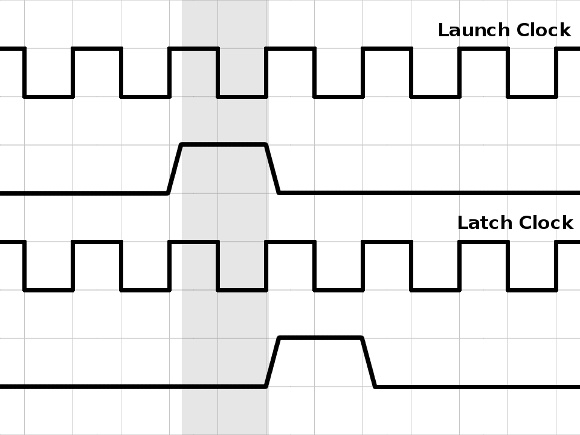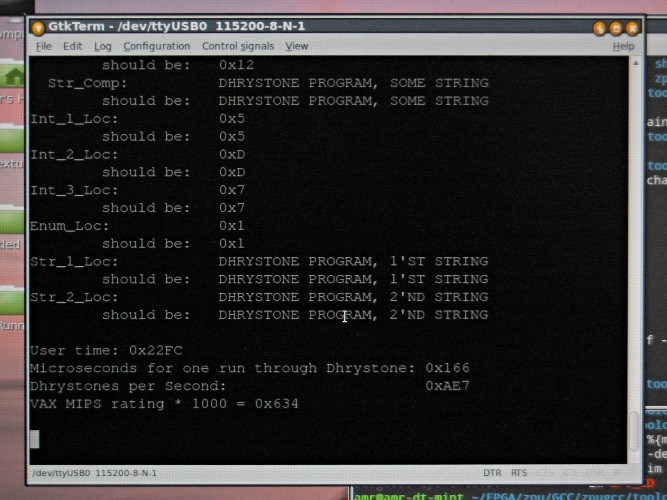…is directly proportional to the value of equipment destroyed!”
I don’t know who first coined this phrase, but it’s always struck a chord with me.
I came close to gaining lots of experience in the last week!
Continue reading

…is directly proportional to the value of equipment destroyed!”
I don’t know who first coined this phrase, but it’s always struck a chord with me.
I came close to gaining lots of experience in the last week!
Continue reading
My Vampire500 board came with “some assembly required” – the FPGA, SDRAM and level translators were all in place, but installing the non-essential stuff – the micro SD slot and PS/2 socket – was left as an exercise for the user!
I want to press the Micro SD slot into service so that I can load alternative Kickstart ROMs, because my old A500 board has kickstart 1.3, and I need a more up-to-date ROM to test Zorro III autoconfig, and to run certain test software.
As it happens I haven’t done any surface mount work before, so I was a bit nervous about attacking an almost-one-of-a-kind board with a soldering iron – but after butchering the control board from a dead hard-drive and convincing myself that I *am* capable of soldering on that scale, I had a go at mounting the micro SD socket. I was relieved to find that it has locating pegs that fit holes in the PCB, so at least I didn’t have to worry about alignment.
Well it *looks* OK – now to see if it actually works!
Building on my previous rather perverse mashup of Amiga and ZPU technology, my old Amiga 500 motherboard currently has not just one, but *two* ZPU processors!
After spending a satisfying few hours tracking down a stubborn bug which turned out to be a mere bad solder joint, my old A500 motherboard is now able to boot using the Vampire500 board in place of the CPU!
Unfortunately, since that means I can now play some old favourites on the board (in the name of testing, of course!) there probably won’t be much more progress today!
I have an Amiga with a ZPU processor!
So what possessed me to create such a perverse combination? Quite simply that it synthesizes in about a third of the time that a TG68-based equivalent would, which speeds up the development cycle significantly while I’m bug hunting.
(I will admit there’s an element of “because I can” there, too!)
This not-very-exciting screenshot shows a simple program running on the ZPU, and testing the reliability of reads and writes to Chip RAM through the Vampire500. The program simply sets up a 2-colour high-res screen, clears the framebuffer, and then repeatedly adds 1 to each longword within the framebuffer. Any glitches in either reading or writing would thus be cumulative, so if I can leave the program running for a while and if the pattern on screen remains in nice neat columns (which it does), I can be sure that no glitches have occurred. (Or that any errors are perfectly consistent!)
Of course, a ZPU-based Amiga is of no practical use whatsoever, besides assisting in debugging the Vampire500 – but I find myself idly wondering how practical it would be to use a more modern CPU – such as, perhaps, the OR1200 – and then emulate the 68000 in firmware?
Anyhow, pipe-dreams aside, the next task will be to take a checksum of the Kickstart ROM, since ROM reads are the only kind I haven’t yet tested.
I have another new toy to distract me from all the things I should be doing!
This is one of Majsta’s hand-assembled prototypes of his FPGA accelerator, connected to a spare A500 motherboard that I just happened to have lying around. (I don’t currently have an A600 to play with, which is why Majsta sent me the less-mature A500 variant of the project). While I’ve been trying to help with the SDRAM problems his project’s run into, there’s only so much I can do without access to the hardware. Well, now I have that access!
The A500 variant of the project’s not yet as complete as the A600 version, and can’t yet boot from the TG68 processor, so now begins the fun of testing the various kinds of accesses to the A500 motherboard, and ironing out the glitches.
Because the whole project takes some time to build, while I’m testing and diagnosing I’m using a simple state machine to simulate the CPU, which looks like this:
library ieee; use ieee.std_logic_1164.all; use ieee.std_logic_unsigned.all; use ieee.numeric_std.all; entity DummyCPU is generic( SR_Read : integer:= 0; --0=>user, 1=>privileged, 2=>switchable with CPU(0) VBR_Stackframe : integer:= 0; --0=>no, 1=>yes/extended, 2=>switchable with CPU(0) extAddr_Mode : integer:= 0; --0=>no, 1=>yes, 2=>switchable with CPU(1) MUL_Mode : integer := 0; --0=>16Bit, 1=>32Bit, 2=>switchable with CPU(1), 3=>no MUL, DIV_Mode : integer := 0; --0=>16Bit, 1=>32Bit, 2=>switchable with CPU(1), 3=>no DIV, BitField : integer := 0 --0=>no, 1=>yes, 2=>switchable with CPU(1) ); port(clk : in std_logic; nReset : in std_logic; --low active clkena_in : in std_logic:='1'; data_in : in std_logic_vector(15 downto 0); IPL : in std_logic_vector(2 downto 0):="111"; IPL_autovector : in std_logic:='0'; CPU : in std_logic_vector(1 downto 0):="00"; -- 00->68000 01->68010 11->68020(only some parts - yet) addr : buffer std_logic_vector(31 downto 0); data_write : out std_logic_vector(15 downto 0); nWr : out std_logic; nUDS, nLDS : out std_logic; busstate : out std_logic_vector(1 downto 0); -- 00-> fetch code 10->read data 11->write data 01->no memaccess nResetOut : out std_logic; FC : out std_logic_vector(2 downto 0); -- for debug skipFetch : out std_logic; regin : buffer std_logic_vector(31 downto 0) ); end DummyCPU; architecture rtl of DummyCPU is type states is (write1,write2,write3,write4,write5,write6,read1,read2); signal state : states := read1; signal counter : unsigned(15 downto 0); signal temp : std_logic_vector(15 downto 0); begin process(clk) begin nResetOut<=nReset; if nReset='0' then state<=read1; elsif rising_edge(clk) then case state is when write1 => data_write<=temp; -- std_logic_vector(counter); addr<=X"00DFF180"; busstate<="11"; -- Write data state<=write2; nWR<='0'; nUDS<='0'; nLDS<='0'; when write2 => if clkena_in='1' then state<=write3; end if; when write3 => addr<=X"00BFE201"; data_write<=X"0003"; -- Set OVL and LED as output nWR<='0'; nUDS<='1'; nLDS<='0'; -- Byte write to odd address. state<=write4; when write4 => if clkena_in='1' then state<=write5; end if; when write5 => addr<=X"00BFE001"; data_write<=X"FFFF"; data_write(1)<=temp(6); -- Echo mouse button status to keyboard LED. nWR<='0'; nUDS<='1'; nLDS<='0'; -- Byte write to odd address. state<=write6; when write6 => if clkena_in='1' then state<=read1; end if; when read1 => addr<=X"00BFE001"; busstate<="10"; -- Read data state<=read2; nWR<='1'; nUDS<='1'; -- Byte read from odd address. nLDS<='0'; when read2 => temp<=data_in; if clkena_in='1' then state<=write1; end if; end case; end if; end process; end architecture;
This state machine reads the value of CIA-A PRA and writes the value read to the COLOR0 register, so the colour of the screen changes in response to the mouse or joystick buttons. It also writes the status of the left mouse button to the LED bit, so the keyboard LED lights in response to the mouse button.
Next I shall test reads and writes to Chip RAM and reads from the Kickstart ROM for reliability.
I’ve been playing around with the ZPU again, and exploring what’s needed to get such things as malloc() and rudimentary filesystem support working. By re-using the FAT filesystem code from the Minimig project’s firmware and creating a simple wrapper, I now have a complete enough system that I can load and display a JPEG file from SD card.

An image in the process of being loaded
A 640×480 JPEG currently takes approximately 39 seconds to load and display – my next project will be to explore hardware acceleration of the DCT and see how much faster this can be made.
A binary snapshot with DE1 and DE2 bitstreams, and files to go on the SD card can be found here
The source repo is tagged to match this snapshot.
With its tiny size the ZPU would seem an ideal candidate for a multi-core design. Unfortunately, instantiating more than one of the traditional zpu_small cores in a single project is complicated by the ROM / Stack RAM entity being instantiated within the CPU core itself. If you want multiple ZPUs, doing different jobs, then their ROMs must differ! To solve this, I’ve removed the internal ROM and defined a new interface (using VHDL techniques I’ve picked up from the PACE project) for connecting the ZPU to a separate ROM / Stack RAM entity. The biggest advantage of this is that it makes it much simpler to swap between different firmwares. Continue reading
When designing a system with various virtual components all within an FPGA, transferring data from one module to another is fairly straightforward. Provided the two modules use the same clock, we simply send outgoing data on a rising clock edge, and sample it in the receiving module on the following rising clock edge. The new data has a complete clock cycle in which to propagate from the source to the destination.

Things become more complicated, however, when the modules aren’t in the same chip. A typical example is making an FPGA-based project communicate with SDRAM.
Continue reading
Things are getting interesting with the ZPU core, and it’s now pretty much where I want it for inclusion into other projects.

Continue reading